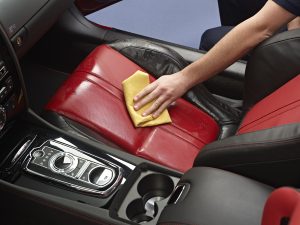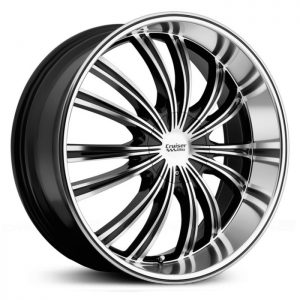What is beading
Written by: Vinnie van Rooij
Beading is the visual effect that a difference in surface energy and surface tension gives. Beading gives an indication of how a liquid behaves on a certain surface. Many manufacturers put a lot of time and effort into trying to get the best beads. Many people believe that good beading must mean good sheeting, but this is not the case. Beading is one of the most popular side-effects that a good form of protection gives.
Contents
What is a bead
Protective products offer a low surface energy. A liquid on the other hand has a similar trait called surface tension. Water has a certain surface tension, and when that comes into contact with a low surface energy, it gets repelled. The surface tension of the waterdrop will pull harder on itself then the surface underneath it pulls on it. This means that the molecules are more attracted to each other, then to the surface it touches. The result is a nice round bead. The difference in energy also has an effect on how easily the liquid can bond on the surface. A nice round drop has less contactsurface with the surface underneath, which means there is less microscopical contact that can cause the waterdrop to stick to the paint.
Wetting

When a liquid touches a surface, there is a certain reaction. Depending on the surface tension and the surface energy the liquid will deform in a certain way. If the drop of liquid has a higher surface tension than the surface energy from the solid surface, the liquid droplet will show a shape that looks more like a round ball. The higher the difference, the rounder the ball. The lower the difference, the flatter the ball will be. This is called wetting. The higher the difference the less wetting. The lower the difference, the more wetting.
When the surface tension of a liquid is lower then that of the solid surface it touches, it will actually form a sheet that does not resemble any round form. This is called total/complete wetting.
This science is also used when creating paint, glue and cleaning liquid. A shampoo has surfactants, these ingredients actually lower the surface tension of water, which allows it mix with other materials more easily.
To put it in very simple terms: surface tension is like a shield. The higher this shield, the more difficult it is to penetrate the shield. A surfactant lowers the strength of the shield, making it easier to penetrate the shield. When it is easy enough to penetrate the shield, a water/soap mixture will more easily mix with grease, dust and other particles. Thus increasing its ability to clean.
Shampoo needs a high wetting ability to do its job.
Contact angle
A bead is measured by the contact angle. This is the angle between the surface and the edge. Wetting and Contact Angles are intertwined. A high contact angle mean very little wetting, its mainly a different way of saying the same thing.

Sheeting and beading
Some people think that beading and sheeting is the same effect. Unfortunately this is not true. Sheeting is a different property then beading. In many cases manufacturers of protective products try their best to get nice beading and great sheeting. Beading causes nice round drops of liquid, sheeting then allows that drop of liquid to roll off the surface at a low angle. The lower the angle is needed to shift the drop of water, the better the sheeting.
Types of beads
There are a few different types of beading.
They usually show up in the following order:
High contact-angle beading (often referred to as the “proper beading”)

Deminished beading (they show some roundness, but they are getting less round. The edges are rough and the contact angle is very low)

Giraffe beads (because they look like the pattern on the hide of a Giraffe)

No beading anymore (the water just lies on the surface as 1 big sheet)

Beads and strength of protection
The common misconception is that beading guarantees protection. The lack of beads has to mean that the protection is gone. This is not true.
Wax for example is porous and Hydrophilic in nature. This means that in time, wax will start to trap moisture and dirt will get trapped in it. These contaminants and increased Hydrophilic property will raise the surface energy, and decrease the difference between surface energy and surface tension. A droplet of water will show up as a less round bead.
Even though there is still a layer of wax present, the bead will show flat.
Another good example is a ceramic coating. Even with regular washing there will still be certain contaminants that will stick to the surface that won’t be removed by normal washing. In time, the surface will get contaminated with small particles. These particles raise the surface energy and create more microscopic uneveness for the waterdroplet to stick to. The result is very patchy sheeting and flat beads.
The layer of ceramic coating underneath is still present, and even mostly unaffected by the contaminants. But still the beads show up with rough edges and a very low contact angle.
This can easily be fixed with a proper wash with a acidic washing solution, such as some wheel cleaners. After washing with this solution, many of the stubborn contaminants will be removed, and the beads and sheeting will return.
Quality of protection and beading
Beads do not indicate a good strength of protection, but it can show the quality of protection. When beading goes flat, it is often due to contaminants in the surface of the layer of protection. This can give an indication in how tough the surface is. A harder and more resilient form of protection will repel dirt longer then a soft and weak layer of protection. A recently applied layer of protection will always show nice rounds beads, but only a quality product will still give nice round beads after a longer period if time.
An example:
| A bad wax | A quality product | |
|---|---|---|
| The day of application | Nice round beads | Nice round beads |
| After 1 week | Beads show less round shape | Nice round beads |
| After 2 weeks | Beads get rough edges | Hardly any difference |
| After 1 month | Beads are flat and almost gone | The edges get a little bit rougher |
| After 2 months | Beading is completely gone | Beads are a lot flatter, but not gone |
| After 3 months | Beading is still totally gone | Beads are flat and quite rough |
The difference between a good wax and a bad wax is the time it takes to degrade.
In this scenario the behavior of water actually gives a good indication of the quality of a protective product.
Different related articles
 A leather cleaner is a specially designed product to clean leather in a gentle and safe way. The product is designed to remove dirt and grime without having any effect on the material....
A leather cleaner is a specially designed product to clean leather in a gentle and safe way. The product is designed to remove dirt and grime without having any effect on the material.... Smartwax is an American brand of detailing products located in California. The brand was established around 2003 and has a fairly wide range of products that is being offered via several different resellers....
Smartwax is an American brand of detailing products located in California. The brand was established around 2003 and has a fairly wide range of products that is being offered via several different resellers.... Alloy wheels are specific wheels have been made out of aluminium or magnesium, with certain other elements added. They can come in various shapes and sizes and even the finish can differ greatly between models or brands....
Alloy wheels are specific wheels have been made out of aluminium or magnesium, with certain other elements added. They can come in various shapes and sizes and even the finish can differ greatly between models or brands.... R222 is the European name under which P21S offers its products. P21S is a brand under SmartParts TM located in Connecticut, America. SmartParts can also be known as BIS (Brookside Import Specialties). Which also owns brands such as S100....
R222 is the European name under which P21S offers its products. P21S is a brand under SmartParts TM located in Connecticut, America. SmartParts can also be known as BIS (Brookside Import Specialties). Which also owns brands such as S100.... It is often asked on detailing fora and social media: "what is the best sealant". Off course there is a difference between certain products and brands, but it is important to know what you are asking. In this guide I will try to explain what the problem is with this question unless it is asked more in-depth....
It is often asked on detailing fora and social media: "what is the best sealant". Off course there is a difference between certain products and brands, but it is important to know what you are asking. In this guide I will try to explain what the problem is with this question unless it is asked more in-depth.... Bufffiber is a Dutch car detailing accessories brand. The company was launched in 2017, after a year of internal product development the first products were launched to the general public in the fourth quarter of 2018. At this moment Bufffiber specializes exclusively on high-end Korean microfiber car detailing products, with an intention to expand its product selection in 2019/2020....
Bufffiber is a Dutch car detailing accessories brand. The company was launched in 2017, after a year of internal product development the first products were launched to the general public in the fourth quarter of 2018. At this moment Bufffiber specializes exclusively on high-end Korean microfiber car detailing products, with an intention to expand its product selection in 2019/2020....







Links to this article
There are no external links to this article. Yet.